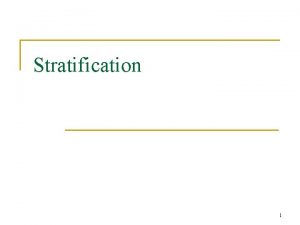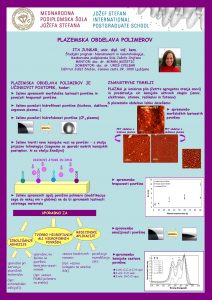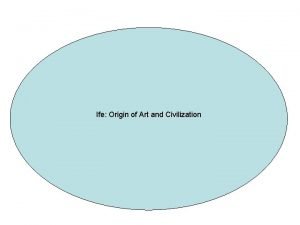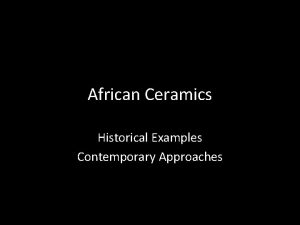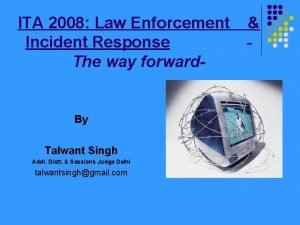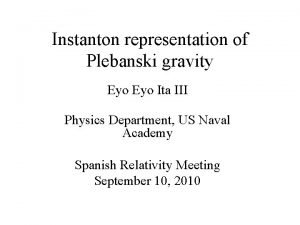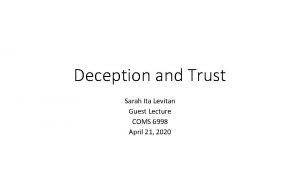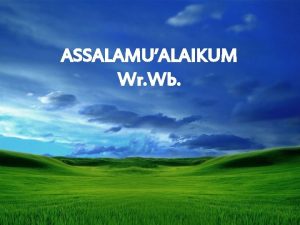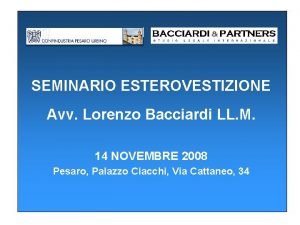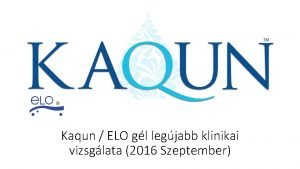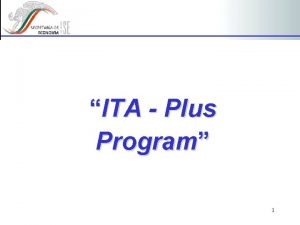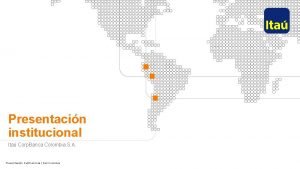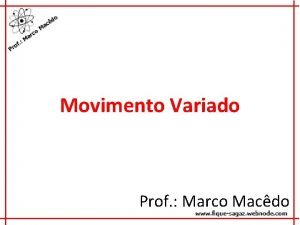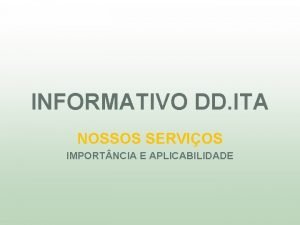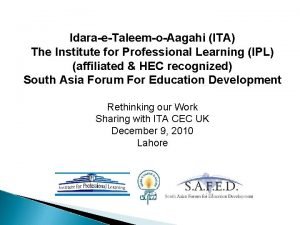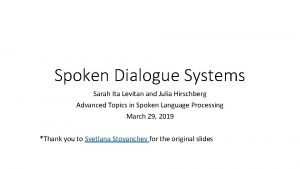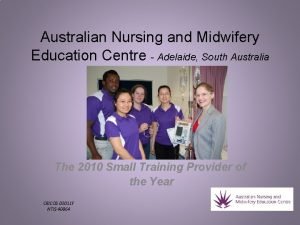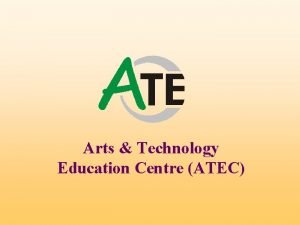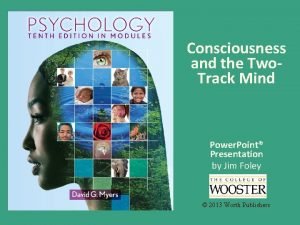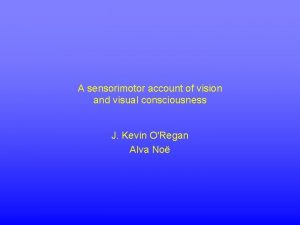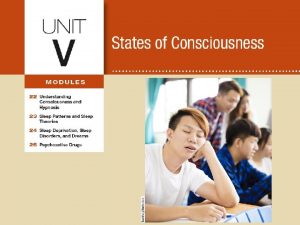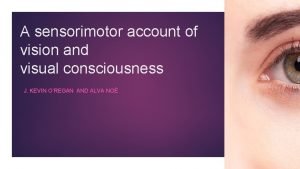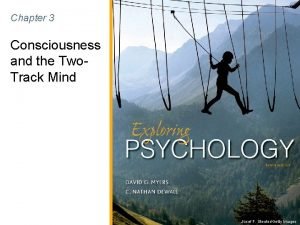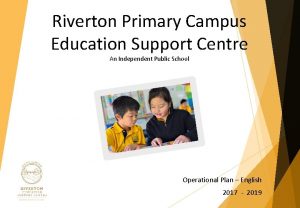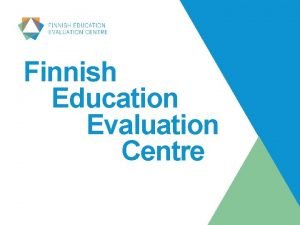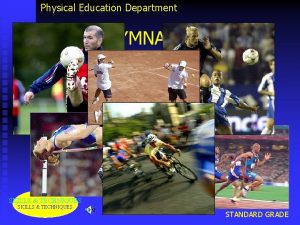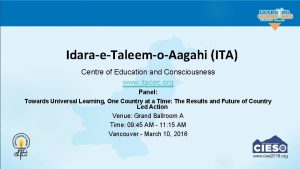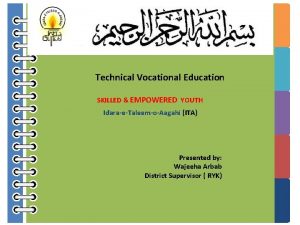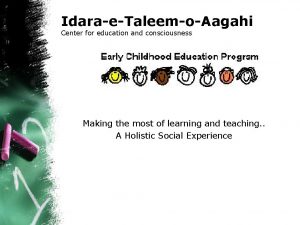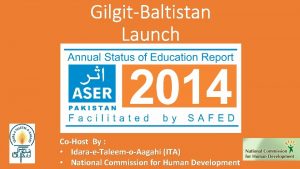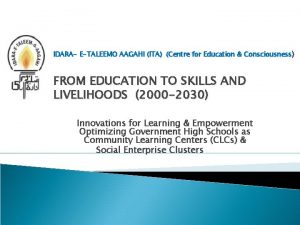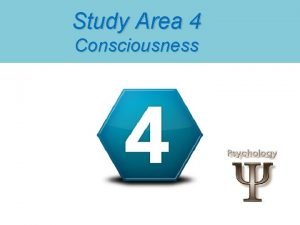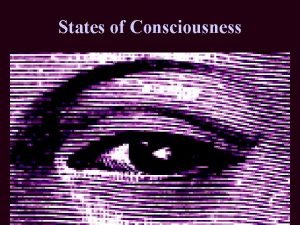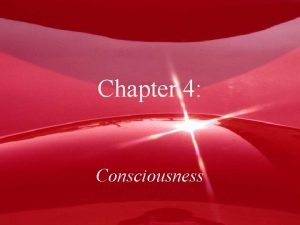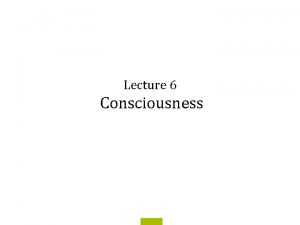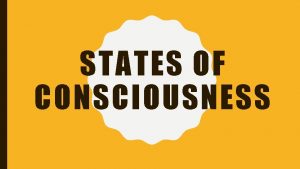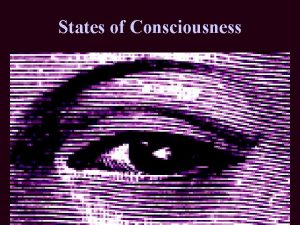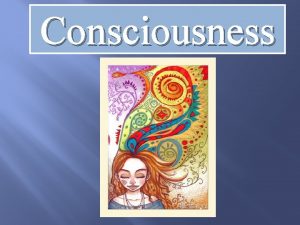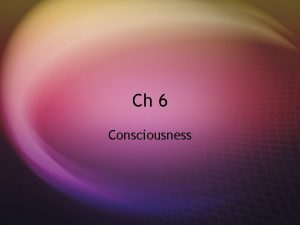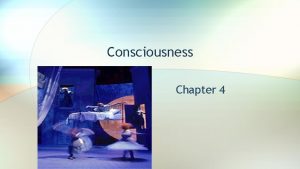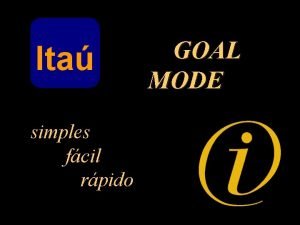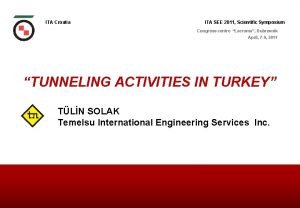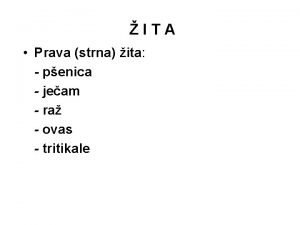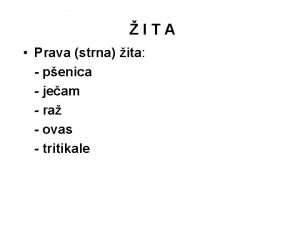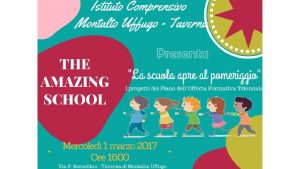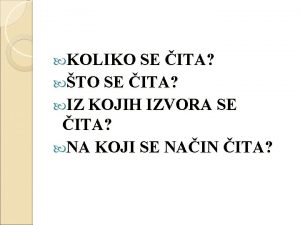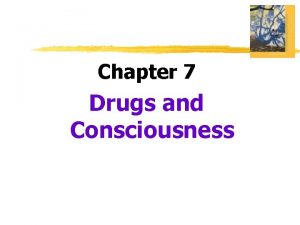IdaraeTaleemoAagahi ITA Centre of Education and Consciousness www





































- Slides: 37

Idara-e-Taleem-o-Aagahi (ITA) Centre of Education and Consciousness www. itacec. org Panel: From citizen-led assessment to action for learning in Asia and Africa Venue: Room 661 – Sheraton Hotel - Time: 01: 15 PM - 02: 45 PM Vancouver - March 07, 2016 1

Learning for Access: Impact on Enrolment and Learning Levels of Children case study of a program supported by Dubai Cares 2014 -2016 in Pakistan 2

Presentation q. Introduction q. Definition of OOSC q. Case of Pakistan q. Learning for Access Program-Framework q. Achievements: enrolment and learning levels q. Impact evaluation results q. Conclusion 3

Introduction • Education is a ‘powerful tool to help marginalized groups reduce poverty accessing entitlements as active citizens’ • Nearly 57 million children of primary school age (6 and 11 years of age) are not enrolled in school • Two-fifths of these children—or 15 million girls and 10 million boys—are unlikely to ever set foot in a classroom • 250 million of children going to school are not learning • MDGs 2 & 3 and EFA targets led to improvements, but remained off track in 2015 as unfinished business, to be met through SDGs 2030 & SDG 4 4

Definition of Out of School Children (OOSC) • The Global Partnership for Education (GPE) has defined the term OOSC to include children who: Do not have access to a school in their community Drop out of the education system Out of School Children (OOSC) includes children who: Do not enroll despite the availability of a school Enroll but do not attend school 5

Through this program we : Enrolled but at risk of dropping out Drop outs Cater for Children who are: Un-enrolled even when Schools are Available Unenrolled & of school going age 6

Factors that Limit Access to Schools Income poverty Poor health and nutrition Disability Gender Ethnicity Child labor Migration Geographical disadvantages Cultural factors Fragility and conflict 7

The case of Pakistan • Pakistan is at the centre of unmet global MDG/EFA targets & OOSC- takes second position after Nigeria estimates of 5. 7 million at primary level and 25 million for age groups of 5 -16 who do not access education facilities • The 18 th Amendment (Article 25 -A) made in 2010 to the constitution of Pakistan declares education as a fundamental right guaranteed by the State • 3 out of 4 provinces and federal areas have legislated to implement Article 25 -A- rules just being framed • Innovations are being tested to address challenges of learning and access 8

ASER 2015 Results: Out of School children (Age 6 -16 years) 12. 7% 20. 5% 29. 5% 15. 3% 4% 15. 5% 25. 7% 9

The project has Interventions – for –learning- transition & support Early Childhood Education (ECE) in schools Access & Learning for Out of School Children (OOSC) through CAMa. L Learning for Access (L 4 A) program Teachers without Frontiers - unique blended learning eenabled platform for professional development in far flung districts Learning Assessment (LMTF / ASER etc) Children’s Literature Festival & Publications Advocacy and influencing government policy – provincial, national ASER +RTE Improving learning outcomes, enrolment and transitions from ECE to primary education especially for girls and vulnerable groups in Pakistan Partners: Government + Private Sector + Civil society 10

Learning for Access Program • The program builds on Five Dimensions of Exclusion framework; targets children of Dimensions 1, 2, 3 & 4 • For learning levels it is implemented at village level for one year duration in two phases • For ECE it is implemented for 2 years in the same locality & schools 11

How is it different from other mainstreaming programs? 1) Mainstreaming OOSC by Identifying the ‘as is’ learning levels of children out of school going age, instead of assuming their levels based on their age or grades. 2) Targeting potential drop outs and in school children at risk from grades 3 -4 -5 3) Adopting “Accelerated learning program Combined Activities for Maximized Learning (CAMa. L)”. The techniques help learners achieve all 5 competencies – Listening, Speaking, Reading, Writing and Doing- establishing each child’s learning baseline –with midline and end line testing prior to mainstreaming (Language I, English and numeracy) 4) Para teachers are from the same community- trained and paid a modest honorarium (US $3. 5 -5 p. m. ) 5) In each government school, a focal teacher is also trained in the methodology to sustain the program 6) Innovations on advocacy learning and assessments through : ASER+RTE, Technologies – Blended learning TWF; CLF alternative pedagogies & LMTF – learning champions 12 7) Government a witness to the program as 99% of the program is in government schools

Stage 1: Implementing strategy of CPB Duration: 03 months • Conduct a school survey to identify schools that require support • Identify children from grades 3, 4 and 5 of these schools who are at a risk of dropping out • Conduct a 100% household survey to identify OOSC in the communities • Conduct ‘Baithaks’ or community meetings to disseminate results of the household survey and convince the community the need to send OOSC to schools • Identify Para teachers from amongst the community who are willing to bring OOSC to schools and teach • Train the Para Teachers according to a CAMa. L methodology - Combined Activities for Maximized Learning – if camp is conducted in school, one school teacher is also taught the methodology • Set up Chalo Parho Barho (CPB) Camps at the identified school premises or available community spaces after school hours (2 -3 hours every day for 45 days) • Ensure Para Teachers /community volunteer mobilize identified OOSC and in school children to the camp 13

Stage 1: Implementing strategy of CPB • 65 days of camp • Maximum 40 students in one camp Baseline assessment 15 days camp 3 -5 days 2 nd term assessment 1 st term assessment 15 days camps 3 -5 days Final assessment 3 -5 days 14

Stage 2: Whole School Improvement Program Ensure retention of children Duration: 12 months-concurrent to the 3 months learning camps • Strengthen School Management Committees (SMCs) – as an accountability group making School Improvement/Development Plans (annual) • Provide Teaching Learning Materials (TLMs), small libraries/reading kits /sports kits/health for children. • Establish Students Club to encourage students to conduct school enrichment activities • Track learning levels of mainstreamed children • Mainstream Para teachers into the schools to help with the increased enrolment- so para teachers continue to support enhanced numbers whilst govt. works on hiring/rationalizing additional teachers • Build capacity of all school teachers through regular subject-based trainings • Maintain and repair very basic but necessary school infrastructure (black board, classroom, toilets, water facility, essential furniture) 15

Achievements of the program Phase I Sept 2014 to May 2015 16

Scope and achievements: Learning for Access (L 4 A) Province District Schools OOSC Sindh Karachi 10 400 Sukkur 200 8000 Shikarpur 90 3600 Quetta 9 360 Qila Saifullah 11 440 Lasbela 80 3200 Lahore 10 400 Muzaffargarh 60 2400 Rahim Yar Khan 50 2000 Bahawalpur 26 1040 10 Districts 546 Schools 21840 Balochistan Punjab 3 Provinces 17

Scope and achievements : Learning for Access (L 4 A) – Phase 1 District No of schools Boys (OOSC) Girls ( OOSC) Total (OOSC) Sukkur 86 1186 1067 2253 Shikarpur 46 834 789 Lasbela 38 510 MZG 30 Total 200 Boys ISC Girls ISC Total ISC + OOSC 316 224 540 2793 1623 704 320 1024 2647 300 810 4 814 725 833 1558 339 553 892 2450 3255 2989 6244 1363 1097 2460 8704 18

Scope and achievements: Learning for Access (L 4 A)-Term 1 S. No District 1 Sukkur No of Children No of children in CPB Camps Mainstreamed 2253 1611 % Percentage mainstreamed 71. 50 2 Shikarpur 1623 1451 89. 40 3 Muzaffargarh 1558 1536 98. 58 4 Lasbela 810 660 81. 48 Total 6244 5258 84. 20 CPB camps in term 2 are on closure and data is still under process. Estimated 14000 -15000 OOSC are passing out from CPB camps. 19

Scope and achievements: Learning for Access (L 4 A) Learning Level : Urdu / Sindhi Nothing Letter Word Sentence Story 60 50 40 30 20 10 0 Baseline 1 st Term 2 nd Term final term 20

Scope and achievements: Learning for Access (L 4 A) Learning Level: Mathematics Not Idtfy Number Recg. (1 -9) Number Recg. (10 -99) Addition Subtraction Multiplication Division % of students 80 60 40 20 0 Baseline 1 st Term 2 nd Term final term 21

Scope and achievements: Learning for Access (L 4 A) Learning Level: English Beginner 80 Letter Word Sentence % of stduents 60 40 20 0 Baseline 1 st Term 2 nd Term final term 22

LEARNING LEVEL - Baseline vs 1 st, 2 nd & Final Term Learning Camps –Results Math Assessment Total Letter Word Sentence Story Not Idtfy Number Recg. (1 -9) Number Recg. (10 -99) Addition Subtraction Multiplication Division Beginner Letter Word Sentence English Nothing Urdu/Sindhi Baseline 8790 4440 2199 905 428 818 3304 2709 1080 502 374 385 436 6333 1346 760 351 1 st Term 8780 819 4004 2087 913 957 440 3108 2419 1036 830 490 457 823 4700 2648 609 2 nd Term 8727 159 2078 3531 1751 1208 74 1275 2740 2213 1128 683 614 194 3886 3124 1523 3 rd Term 8704 0 304 2600 3131 2669 0 127 1047 2872 2336 1307 1015 5 2082 3226 3391 Improvements in Learning across 3 camps ! 23

Improvement in Learning Levels Transition of Children across Urdu/Sindhi Baseline vs Final term (% of students) Nothing 51 0 Letter 25 3 Word 10 30 Sentence 5 36 Story 9 31 Improvement trends 24

Improvement in Learning Levels Transition of Children across Mathematics Baseline vs Final term (% of students) 38 0 Identify number 1 -9 31 1 Identify number 10 -99 12 12 Addition 6 33 Subtraction 4 27 Multiplication 5 15 Division 5 12 Nothing Improvement trends 25

Improvement in Learning Levels Transition of Children across English Baseline vs Final term (% of students) Nothing 72 0 Letter 15 24 Word 9 37 Sentence 4 Improvement trends 39 26

Impact Evaluation Results- round I Round II in May –June 2016 27

Data collection • The data was collected by National Commission for Human Development (NCD), a public sector semi- autonomous body working in the education sector across Pakistan with offices /staff in all districts -well versed in ASER survey tools • The data is collected from four districts of Sukkur (66 schools), Shikarpur (32 schools), Lasbela (20 schools) and Muzaffargarh (20 schools); provides information on basic schools’ characteristics, teachers’ characteristics, children’s characteristics and children’s assessment scores. • Three independent researchers based in UK & Pakistan generating data analysis and reports 28

Model • Our modelling approach involves the comparison of learning outcomes in treatment versus control schools at a given point in time. • the OLS regression is estimated using a rich vector of individual, household, school and teacher level variables. • Individual variables: child age, gender, the age at which the child started school, nutrition (number of meals a child eats in a day), health (whether the child reports any hearing difficulties) • Household: parental education (mother’s literacy), family educational inputs (private tuition and help with homework). The regression also controls for household socio-economic status (SES) through a wealth index. • School variables: whether it is a boys or girls only school (compared to a base of a mixed school) and medium of instruction. • Teacher variable: teacher age, gender, education level, whether the teacher has received pre-service training and teacher contract status 29

Results • Once school and teacher characteristics are controlled for, learning outcomes in Mathematics and English show a very pro male bias as boys perform better. • Teachers with at least BA qualifications and those with pre-service training have a positive impact on learning outcomes in the languages. • For school characteristics, the study finds that girls studying in single-sex schools achieve better learning outcomes in Maths and English than those children studying in mixed schools. • there is a highly significant and positive teacher intervention with the introduction of para teachers. • Infrastructure interventions do not appear to have improved outcomes in this short time frame • the provision of kits continues to have significantly improved student outcomes across the three subjects with the effect being significantly higher in Maths than in Urdu or English. • the L 4 A para teachers have exhibited substantially improved learning outcomes for children. • It is also interesting to see that both Balochistan and Sindh – the two provincial fixed effects – have negative signs and this suggests that the outcomes of children in both these provinces are worse than those of children in Punjab 30

Impact The Roots of Education are bitter, but the Fruit is sweet (Aristotle) Khadeeja bibi is one of the students from CPB camp at Government Primary School Basti Arain No. 2 district Bahawalpur in sub-district Ahmed Pur East. Previously she used to get education from, Parveen, a lady in her neighborhood. However, Parveen got married and moved away to a distant locality. Khadeeja’s father did not allow her to travel to Praveen’s inlaws’ residence; her learning link was snapped depriving her of her basic right to education. The para teacher hired during the survey met with Khadeeja’s father and inquired the reason for not sending Khadeeja to school. He responded that she is already twelve years old and it will be difficult to enroll her in school. After holding a series of meeting with the parents, the para teacher was able to convince them to send her to the camp. During our meeting with Khadeeja, she shared the inexplainable joy she felt on her first day at the camp. She is working tirelessly to ensure that she gets admitted to 2 nd grade after the completion of the camp. Not only is Khadeeja changing her life but she has become an advocate of education convincing her friends to also join school. Khadeeja dreams of being a teacher herself so that she can ensure the right to education of girls in her locality… a passionate and hardworking Khadeeja will indeed further mission of quality education. 31

Up scaling: From Evidence to Action • CPB is incorporated as part of ASER 2 – 2016 -2020 or 2025 – iterative learning improvement and assessments • ASER II in its phase I will focus on CPB camps covering more than 250, 000 children in 12 districts all over Pakistan over 2 years expanding to 1 million over 4 years with large teams in collaboration with the provincial governments. • School stabilization support in essential services (infra/teachers/ missing facilities) will be met through govt. funds now increasingly available through govt. resources provided directly to schools through –non-salary budgets (NSB) and school specific budgets (SSB) 32

Government owning the approach • Parho Punjab Barho Punjab (read Punjab grow Punjab) is one massive govt. campaign mode program for the whole province (100 million + population) with roots in CPB • Punjab: Program Monitoring and Implementation Unit (PMIU) taken ideas from CBP – put some questions on tablets to test randomly 10 -15 children in each school(grade 2 -3) for basic numeracy and literacy. We can question the efficacy of this model but a beginning has been made. • Punjab: Education District Officer Rahim Yar Khan after training of government officials on CPB methodology endorsed the program and promised to implement across the district through government trained officials. • Sindh: NFE sub-committee on learning materials and curriculum is building a similar accelerated learning program to mainstream OOSC (of school going age) through bridge programs who meet the required learning levels according to their age- ITA teams working closely with them • Balochistan: after visits by PPIU (Policy Planning and Implementation Unit) in intervention schools a discussion has begun on mainstreaming positive results too to expand work in Balochistan in collaboration with Education Department. 33

Conclusion • Highlights the effectiveness of learning model camps to reduce the number of OOSC in a community and to improve learning levels of enrolled children as an effort to retain and help transition from primary to post primary levels • CAMa. L Methodology allows for close connection between teachers and the children, builds interest of the children to come to school and that of the teachers’ to help children progress to the next stage of learning • Grouping and teaching of children according to different learning levels gives children a chance to improve with peers in a non-threatening environment • Engagement of local community members as para-teachers for the camp raises awareness of the need to enroll all children in schools, provides easy access to the community to solve problem themselves - The model leverages demand supply side realities while creating sustainable solutions through simple and cost-effective strategies - Its other innovative dimensions- TWF-blended learning -technologies- LMTF, CLF & ASER influencing government policies and systems & low cost private sector school programs in same districts provincial and across Pakistan 34

35

Annex – CPB Assessment Tools 36

Annex – CPB Assessment Tools 37
 Occupational prestige ratings
Occupational prestige ratings Statics
Statics Center of gravity formula for different shapes
Center of gravity formula for different shapes Counterbalance forklift ita classification
Counterbalance forklift ita classification Ita junkar
Ita junkar Ritual pot
Ritual pot King from ita yemoo
King from ita yemoo Ita 2008
Ita 2008 Eyo ita physics
Eyo ita physics Sarah ita levitan
Sarah ita levitan Sepuluh tahun yang lalu umur ita dua kali umur tika
Sepuluh tahun yang lalu umur ita dua kali umur tika Ita
Ita Ita skin
Ita skin Ita plus
Ita plus Ita
Ita Ita
Ita Sottotitoli ita
Sottotitoli ita Banco colombia
Banco colombia A borda de um precipicio de um certo planeta
A borda de um precipicio de um certo planeta Dd ita
Dd ita Pelipsu
Pelipsu Sarah ita levitan
Sarah ita levitan Anmec adelaide
Anmec adelaide Technology education centre
Technology education centre Two track brain
Two track brain A sensorimotor account of vision and visual consciousness
A sensorimotor account of vision and visual consciousness Social influence theory of hypnosis
Social influence theory of hypnosis A sensorimotor account of vision and visual consciousness
A sensorimotor account of vision and visual consciousness Consciouness
Consciouness Plas gwynant outdoor education centre
Plas gwynant outdoor education centre Frank chapman centre
Frank chapman centre Burwardsley school trip
Burwardsley school trip Riverton education support centre
Riverton education support centre High ashurst cabins
High ashurst cabins Frank chapman outdoor education centre
Frank chapman outdoor education centre Finnish education evaluation centre
Finnish education evaluation centre Borwick hall outdoor education centre
Borwick hall outdoor education centre Center of gravity in gymnastics
Center of gravity in gymnastics
